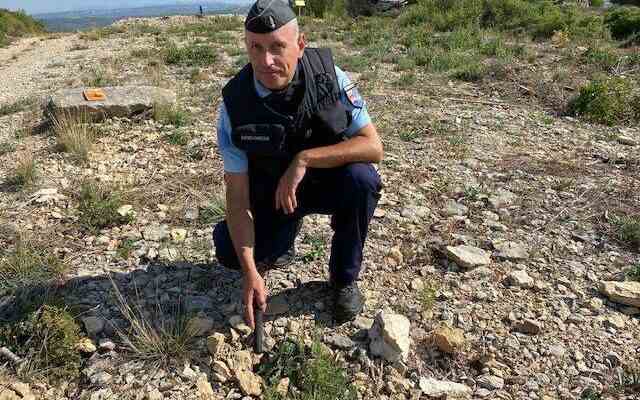The slope is steep. You have to leave the police vehicle halfway and finish on foot to reach this archaeological site located on a rocky outcrop, from where you overlook the Etang de Berre. “It’s not wild boar,” Alexandre Dumont-Castells immediately cowardly saw, near the site, a large circular hole. Doctor in archeology and gendarme assigned to the territorial brigade of Lançon-de-Provence, he is one of the regional referents in the fight against archaeological looting. And there is no doubt for him: the trace is that of a metal detector, the signature of heritage looters.
“Since our last visit, a month ago, I have noted three new excavations, the looting unfortunately continues”, laments the gendarme. On site, no sign mentions the historical importance of this place dating from the Iron Age, although it is well known to treasure hunters. “It is a Gaulish granary-farm from the 5th century BC, partly fortified,” explains Alexandre Dumont-Castells. About forty people probably lived on this site, whose storage capacities were significant: the excavations undertaken in the early 1990s revealed the traces of about fifty large jars, which mainly contained barley. A fire put an end, around the year – 420, to the occupation of the place.
An annual loss of 3 million euros
“There is no real way in open country to fight against looting, except to show that we are vigilant”, recognizes the gendarme, for whom this fight is first and foremost a long work of pedagogy. “Archaeological resources are not renewable resources,” he reminds us. By destroying the archaeological context, looters steal our collective memory. Often, the context tells more about the story than the object itself found. If you take out for example a silver buckle next to the remains of a harness, you probably destroy a necropolis where a Viking is buried with his horse. »
Each year, around twenty cases of archaeological looting are investigated in the region, for damages still estimated at 3 million euros, with in particular the resale on the Internet of coins, fibulae (clothing accessories) and other Gallic objects. found. Work on social networks is also one of the main areas of investigation. Not easy indeed to grasp the fact of metal detectorists, even if they often act on weekends and during the day. “There are visible remains like this, but three-quarters of the looting is done on sites that are not known,” explains Alexandre Dumont-Castells. Often, reports of wild excavations are reported by hikers.
For the three new traces around the farm-granary of Coudounèu, an “administrative report” will be made to the regional archeology service. At this stage, given the lack of material elements, the opening of an investigation is indeed not relevant. These observations, however, enrich a database that may prove useful when the time comes. “It’s a small environment where everyone knows each other, these are easier to identify profiles than in drug trafficking, advances Alexandre Dumont-Castells. In general, they are often first-time offenders. They honestly say where they excavated, and we can then cross-check with the base that we have informed. More than the penalty they incur, the looters worry first about whether the metal detector will be returned to them. Another treasure in their eyes.

